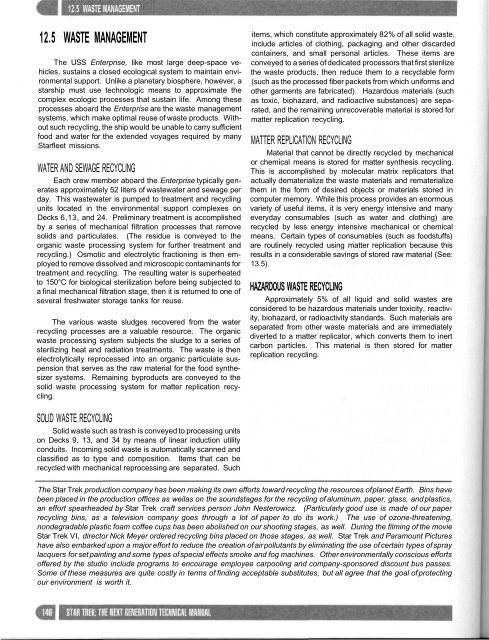franchise-star-trek-tng-technical-manual1
franchise-star-trek-tng-technical-manual1
franchise-star-trek-tng-technical-manual1
Create successful ePaper yourself
Turn your PDF publications into a flip-book with our unique Google optimized e-Paper software.
12.5 WASTE MANAGEMENT12.5 WASTE MANAGEMENTThe USS Enterprise, like most large deep-space vehicles,sustains a closed ecological system to maintain environmentalsupport. Unlike a planetary biosphere, however, a<strong>star</strong>ship must use technologic means to approximate thecomplex ecologic processes that sustain life. Among theseprocesses aboard the Enterprise are the waste managementsystems, which make optimal reuse of waste products. Withoutsuch recycling, the ship would be unable to carry sufficientfood and water for the extended voyages required by manyStarfleet missions.WATER AND SEWAGE RECYCLINGEach crew member aboard the Enterprise typically generatesapproximately 52 liters of wastewater and sewage perday. This wastewater is pumped to treatment and recyclingunits located in the environmental support complexes onDecks 6,13, and 24. Preliminary treatment is accomplishedby a series of mechanical filtration processes that removesolids and particulates. (The residue is conveyed to theorganic waste processing system for further treatment andrecycling.) Osmotic and electrolytic fractioning is then employedto remove dissolved and microscopic contaminants fortreatment and recycling. The resulting water is superheatedto 150°C for biological sterilization before being subjected toa final mechanical filtration stage, then it is returned to one ofseveral freshwater storage tanks for reuse.The various waste sludges recovered from the waterrecycling processes are a valuable resource. The organicwaste processing system subjects the sludge to a series ofsterilizing heat and radiation treatments. The waste is thenelectrolytically reprocessed into an organic particulate suspensionthat serves as the raw material for the food synthesizersystems. Remaining byproducts are conveyed to thesolid waste processing system for matter replication recycling.items, which constitute approximately 82% of all solid waste,include articles of clothing, packaging and other discardedcontainers, and small personal articles. These items areconveyed to a series of dedicated processors that first sterilizethe waste products, then reduce them to a recyclable form(such as the processed fiber packets from which uniforms andother garments are fabricated). Hazardous materials (suchas toxic, biohazard, and radioactive substances) are separated,and the remaining unrecoverable material is stored formatter replication recycling.MATTER REPLICATION RECYCLINGMaterial that cannot be directly recycled by mechanicalor chemical means is stored for matter synthesis recycling.This is accomplished by molecular matrix replicators thatactually dematerialize the waste materials and rematerializethem in the form of desired objects or materials stored incomputer memory. While this process provides an enormousvariety of useful items, it is very energy intensive and manyeveryday consumables (such as water and clothing) arerecycled by less energy intensive mechanical or chemicalmeans. Certain types of consumables (such as foodstuffs)are routinely recycled using matter replication because thisresults in a considerable savings of stored raw material (See:13.5).HAZARDOUS WASTE RECYCLINGApproximately 5% of all liquid and solid wastes areconsidered to be hazardous materials under toxicity, reactivity,biohazard, or radioactivity standards. Such materials areseparated from other waste materials and are immediatelydiverted to a matter replicator, which converts them to inertcarbon particles. This material is then stored for matterreplication recycling.SOLID WASTE RECYCLINGSolid waste such as trash is conveyed to processing unitson Decks 9, 13, and 34 by means of linear induction utilityconduits. Incoming solid waste is automatically scanned andclassified as to type and composition. Items that can berecycled with mechanical reprocessing are separated. SuchThe Star Trek production company has been making its own efforts toward recycling the resources of planet Earth. Bins havebeen placed in the production offices as weilas on the soundstages for the recycling of aluminum, paper, glass, and plastics,an effort spearheaded by Star Trek craft services person John Nesterowicz. (Particularly good use is made of our paperrecycling bins, as a television company goes through a lot of paper to do its work.) The use of ozone-threatening,nondegradable plastic foam coffee cups has been abolished on our shooting stages, as well. During the filming of the movieStar Trek VI, director Nick Meyer ordered recycling bins placed on those stages, as well. Star Trek and Paramount Pictureshave also embarked upon a major effort to reduce the creation of air pollutants by eliminating the use of certain types of spraylacquers for set painting and some types of special effects smoke and fog machines. Other environmentally conscious effortsoffered by the studio include programs to encourage employee carpooling and company-sponsored discount bus passes.Some of these measures are quite costly in terms of finding acceptable substitutes, but all agree that the goal of protectingour environment is worth it.


